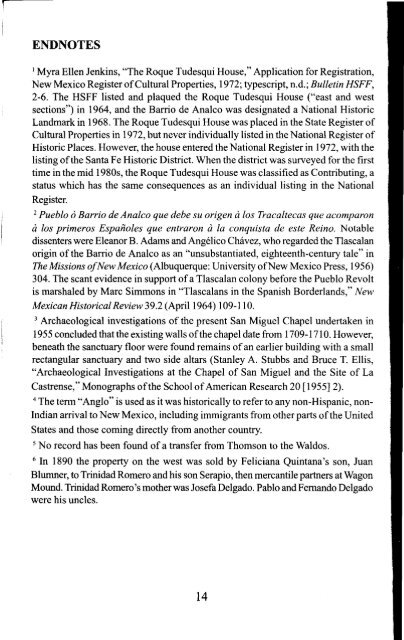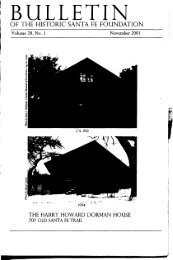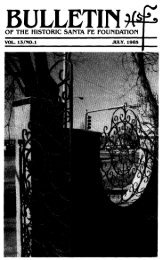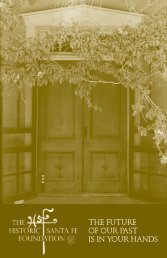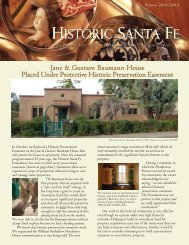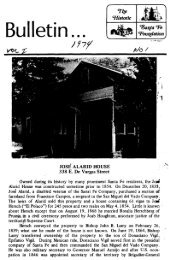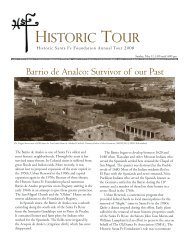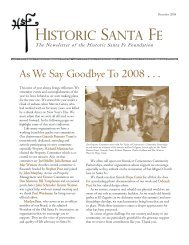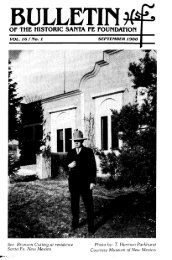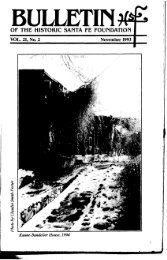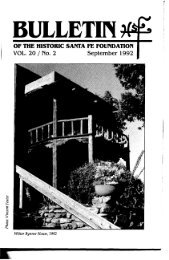Roque Tudesqui House - Historic Santa Fe Foundation
Roque Tudesqui House - Historic Santa Fe Foundation
Roque Tudesqui House - Historic Santa Fe Foundation
You also want an ePaper? Increase the reach of your titles
YUMPU automatically turns print PDFs into web optimized ePapers that Google loves.
ENDNOTES<br />
1 Myra Ellen Jenkins, "The <strong>Roque</strong> <strong>Tudesqui</strong> <strong>House</strong>," Application for Registration,<br />
New Mexico Register of Cultural Properties, 1972; typescript, n.d.; Bulletin HSFF,<br />
2-6. The HSFF listed and plaqued the <strong>Roque</strong> <strong>Tudesqui</strong> <strong>House</strong> ("east and west<br />
sections") in 1964, and the Barrio de AnaIco was designated a National <strong>Historic</strong><br />
Landmark in 1968. The <strong>Roque</strong> <strong>Tudesqui</strong> <strong>House</strong> was placed in the State Register of<br />
Cultural Properties in 1972, but never individually listed in the National Register of<br />
<strong>Historic</strong> Places. However, the house entered the National Register in 1972, with the<br />
listing of the <strong>Santa</strong> <strong>Fe</strong> <strong>Historic</strong> District. When the district was surveyed for the first<br />
time in the mid 1980s, the <strong>Roque</strong> <strong>Tudesqui</strong> <strong>House</strong> was classified as Contributing, a<br />
status which has the same consequences as an individual listing in the National<br />
Register.<br />
2 Pueblo 0 Barrio de Analco que debe su origen a los Tracaltecas que acomparon<br />
a los primeros Espanoles que entraron a la conquista de este Reino. Notable<br />
dissenters were Eleanor B. Adams and Angelico Chavez, who regarded the Tlascalan<br />
origin of the Barrio de AnaIco as an "unsubstantiated, eighteenth-century tale" in<br />
The Missions of New Mexico (Albuquerque: University of New Mexico Press, 1956)<br />
304. The scant evidence in support of a Tlascalan colony before the Pueblo Revolt<br />
is marshaled by Marc Simmons in "Tlascalans in the Spanish Borderlands," New<br />
Mexican <strong>Historic</strong>al Review 39.2 (April 1964) 109-110.<br />
3 Archaeological investigations of the present San Miguel Chapel undertaken in<br />
1955 concluded that the existing walls of the chapel date from 1709-1710. However,<br />
beneath the sanctuary floor were found remains of an earlier building with a small<br />
rectangular sanctuary and two side altars (Stanley A. Stubbs and Bruce T. Ellis,<br />
"Archaeological Investigations at the Chapel of San Miguel and the Site of La<br />
Castrense," Monographs of the School of American Research 20 [1955] 2).<br />
4 The term "Anglo" is used as it was historically to refer to any non-Hispanic, non<br />
Indian arrival to New Mexico, including immigrants from other parts of the United<br />
States and those coming directly from another country.<br />
5 No record has been found of a transfer from Thomson to the Waldos.<br />
6 In 1890 the property on the west was sold by <strong>Fe</strong>liciana Quintana's son, Juan<br />
Blumner, to Trinidad Romero and his son Serapio, then mercantile partners at Wagon<br />
Mound. Trinidad Romero's mother was Josefa Delgado. Pablo and <strong>Fe</strong>rnando Delgado<br />
were his uncles.<br />
14


